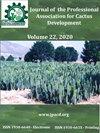摩洛哥仙人掌抗仙人掌品种种子油产量和脂肪酸组成的评价
IF 0.4
4区 农林科学
Q4 HORTICULTURE
Journal of the Professional Association for Cactus Development
Pub Date : 2023-06-19
DOI:10.56890/jpacd.v25i.517
引用次数: 0
摘要
仙人掌仙人掌属植物对摩洛哥的干旱和半干旱地区很重要。来自多刺梨果实种子的可食用和美容油非常珍贵。自2014年仙人掌首次出现在摩洛哥以来,数百公顷的仙人掌遭到破坏,造成了环境和社会经济成本。作为政府全国仙人掌恢复计划的一部分,在摩洛哥各地选择、繁殖和移植了八个仙人掌抗性品种。本研究对这些品种的籽油产量和脂肪酸组成进行了评价。油的提取采用Soxhlet法,使用己烷和机械螺旋压力机。通过己烷提取获得的粗种子油含量范围为9.54%至16.44%(w/w)。机械螺旋提取回收了一半的种子油。脂肪酸图谱显示,这些油是高度不饱和的;UFA部分占总FA的76.31%至82.63%,UFA/SFA比率为3.48至5.36。亚油酸占主导地位,占FA总量的61.50%至68.35%。这些结果突出了抗胭脂虫仙人掌品种作为油源和替代品的重要性,这些油源和代替品已被20多个国家出现的有害规模害虫破坏和威胁。本文章由计算机程序翻译,如有差异,请以英文原文为准。
Evaluation of yield and fatty acid composition of seed oils from cactus varieties resistant to Dactylopius opuntiae (Hemiptera: Dactylopiidae) in Morocco
The Cactus Opuntia spp. plant is important to Morocco's arid and semi-arid regions. The edible and cosmetic oil from prickly pear fruit seeds is very prized. Since Dactylopius Opuntiae first appeared in Morocco in 2014, hundreds of hectares of cactus have been devastated, causing environmental and socio-economic costs. Eight D. Opuntiae resistant varieties were selected, multiplied and transplanted throughout Morocco, as part of the government's nationwide cactus rehabilitation program. This research evaluated the production and fatty acid composition of the seed oil of these varieties. Oil extraction was carried out with the Soxhlet method using hexane and by mechanical screw press. The crude seed oil content obtained by hexane extraction ranged from 9.54% to 16.44% (w/w). Mechanical screw extraction recovered half the seeds' oil. The fatty acid profiles showed that the oils were highly unsaturated; UFA fraction represented 76.31 to 82.63% of total FA and UFA/SFA ratio of 3.48 to 5.36. Linoleic acid was the dominant and represented 61.50% to 68.35% of total FA. These results highlight the importance of cochineal-resistant cactus varieties as oil sources and alternatives to those destroyed and still threatened by the harmful scale pest that appeared in more than 20 countries.
求助全文
通过发布文献求助,成功后即可免费获取论文全文。
去求助
来源期刊

Journal of the Professional Association for Cactus Development
Agricultural and Biological Sciences-Plant Science
CiteScore
1.10
自引率
33.30%
发文量
10
期刊介绍:
The editors of the Journal of the Professional Association for Cactus Development, are very excited to be a part of the excellent editorial committee and to work together to create the synergism between scientists, growers, legislators, and business people so vital to the development of this industry to serve the people of arid lands.
 求助内容:
求助内容: 应助结果提醒方式:
应助结果提醒方式:


